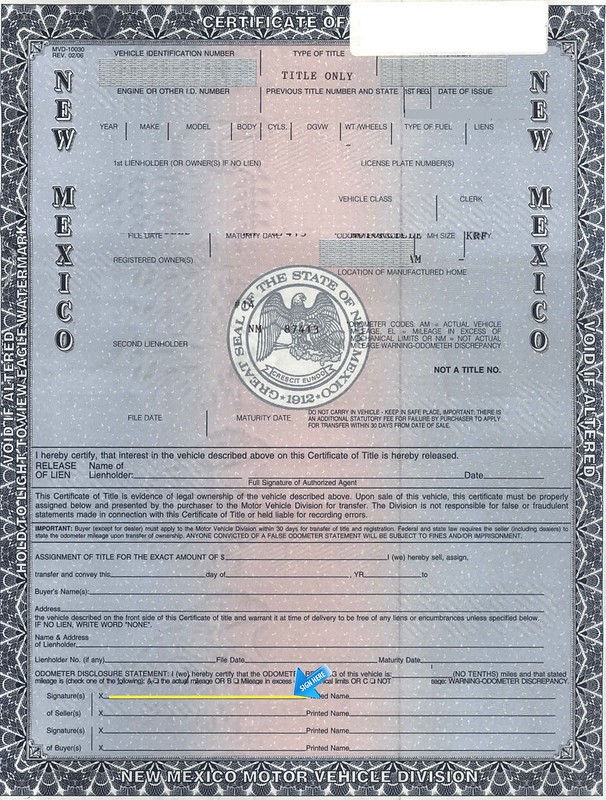So, you’ve found a buyer for your car and need to finalize the sale. First off, congrats – selling a car in such a competitive market can be difficult. If you’re not quite there yet and would like some direction, be sure to check out our guides for selling a car on Craigslist or Facebook Marketplace. The last step is to transfer the Certificate of Title to the new owner. If there’s an outstanding lien on the vehicle, you’ll have to pay that off first to receive the title from the lender. Regardless of your state of residence, the fundamental process remains the same. What should you keep in mind when filling out a car title?
Take your time and don’t rush, write as clearly as possible, and avoid making any mistakes. Use only black or blue ink, and if you do make an error, don’t use whiteout and don’t cross out or scratch out anything. Doing so will likely void the document, meaning you will have to apply for a new one.
But hey, accidents happen, which is why we’ll cover what to do about it later in this article. Let’s first look at what a car title is and why it’s so important, as well as what the risks of not transferring it are. Then, well examine what you’ll need to complete the transfer, and what to do if the title you have is not in your name. Lastly, we’ll go over a step by step guide on how to fill it out, and answer a few of the most commonly asked questions.
What is a Certificate of Title?
The title to your car (known as the Certificate of Title) designates the legal owner of a vehicle to a specific individual(s) or business. All 50 states require a title for the car to be legally driven on the roads. The main reason you’ll need to utilize a Certificate of Title is when buying or selling a vehicle. When it’s with a dealer, they’ll take care of everything for you. But when doing so yourself with a private buyer, it’s up to you to ensure things get handled correctly.
Your car title contains the following information:
- Your legal name
- Your physical or mailing address
- The vehicle identification number (VIN)
- The year, make, model, color, body type, and usage type
- The registered license plate number
- The odometer reading and date when issued
In most states, if there’s still an open lien on a vehicle, the lender will hold the title, meaning you’ll need to pay it off first to receive it. However, in others, such as MD and NY, it gets sent to the buyer but also lists the lienholder. The only way to remove them is to pay any remaining balance owed. To legally sell a car from one person to another, the seller must transfer the Certificate of Title from their name, to the buyer.
There are risks involved in not doing so in a timely fashion. Let’s review.
What are the Risks of Not Transferring a Title?

When you sell a car to someone, you must transfer it out of your name and into theirs. Not doing so could mean that you’re held liable for any trouble the new owner might get into while operating the vehicle. Imagine getting a ticket in the mail a year after selling it, saying you were illegally parked in a handicapped zone. In this case, the car is still in your name as the registered owner, meaning the cost of the ticket is your responsibility.
There’s also a $25 fee applied if you don’t transfer ownership within 30-days, which increases by an extra $25 for each month it’s not resolved. So, not only would you be liable for any legal trouble the new owner might get into with the vehicle, but after a year, you’d owe $325 to the state.
But what if you sign your car over and the new owner never registers it? To protect yourself from this situation, you should go to the DMV website and report that the sale took place. You should also keep copies of the Bill of Sale, the signed over Certificate of Title, and the odometer disclosure. You can either send them or bring them in-person to the DMV.
Now that you better understand the risks associated with not transferring a title out of your name. Let’s look at which documents you’ll need to successfully transfer.
What Will I Need to Transfer my Title?
States differ on which forms you’ll need to successfully transfer a title, be sure to check the DMV website for the specifics to your area. Here are a few of the most common:
- Bill of Sale
While not all states require a Bill of Sale, it’s a great way to further document that there was an exchange of goods from one person to another. You should include the names and addresses of both parties. A physical description of the vehicle (year, make, model, body style, color), as well as the VIN. The odometer reading when the sale took place. The selling price, as well as any taxes paid on the transaction. Lastly, both parties should sign (some states require you to do so in the presence of a notary public).
- Damage Disclosure
As its name suggests, a damage disclosure is required by some states to mention any significant known issues with the vehicle. Doing so protects the seller from possible liability for future repairs.
- Odometer Disclosure
Some states require that you include an odometer disclosure If you don’t write-in the current mileage on the title when you transfer it. It helps keep track of the mileage on vehicle history reports to prevent discrepancies.
- Application for Title
The Application for Certificate of tile is a rather lengthy document that contains the details of both the buyer and seller. While they differ depending on your state of residence, the primary data is the same. It includes a description of the vehicle, the names and addresses of both parties, and any lienholder information. As well as the license plate number, the selling price, and the amount of taxes paid. As you might have guessed, this data then goes onto the new title that’s issued to the buyer.
- Smog Check
Some states require a smog check, such as California. Even if you have an agreement with the buyer, it’s still necessary. This typically ranges anywhere from $30 to $90, which may or may not include a state certification fee of less than $10.
Now that you know what you’ll need to transfer a title. Let’s look at what to do if the title you have is not in your name.
What if the Title is Not in my Name?
If the title is not in your name, then you don’t have the legal right to sell it. Attempting to do so is what’s known as Title Jumping, which is illegal in all 50 states. By buying a car and not registering it in your name, and then selling it, you effectively skip out on having to pay sales tax and registration fees. We’re sure you’re a great person, but many people try to cheat the system by doing this.
To get the title in your name, you’ll have to contact the actual owner and then fill out an Application for Title at a DMV office. You’ll receive a temporary title in the meantime, and then receive the original in the mail shortly after. Be prepared to pay about $15 in fees, as well as any sales tax. If a friend or family member currently holds the title, you might inquire if they would be willing to “gift” the vehicle to you instead to avoid sales tax.
Let’s now look at a step by step guide on how to transfer a title to a new owner.
How to Transfer a Title
The good news is that if you’ve done the research, and know which forms your state requires, then the actual transferring of the title is simple. Some states have just one area for the seller to sign and one for the buyer, others have two or three places to sign for each. The important thing is to read through it carefully to ensure no mistakes are made.
Be sure to pay close attention to the exact names on the title. If there’s more than one person listed, are their names separated by “AND” or “OR?” The former requires a signature from each owner, the latter requires only one from either.
Let’s look at a couple title examples.
Example #1 – New Mexico

Image Credit: kars4kids / Flickr
In this example, the top half will include essential information about the vehicle. Including the year, make, model, body type, fuel type, and the number of cylinders. It will also show the current names and addresses of the registered owners. If there’s a lien on it, then the information for the lender will show, if it’s paid off, they will sign it, releasing themselves from it. You’ll then write in the selling price, the date of the sale, the exact odometer reading, and the name and address of the buyer. And lastly, you’ll sign in the designated seller area, and the buyer will sign in their section just below.
Example #2 – California

Image Credit: kars4kids / Flickr
Example #2 is similar to the first but has an attached addendum to detail the information of the buyer. Once filled out, you’ll need to send this to the DMV to inform them of the transfer.
Example #3 – Washington

Image Credit: kars4kids / Flickr
The same with example #3, just a different format. Vehicle and seller information at the top, then the odometer reading, and lastly, the two highlighted areas for the seller and buyer to sign.
Now let’s look at a few of the most commonly asked questions about transferring a title.
Common Questions When Transferring a Title
- I made a mistake on the title – now what?
As we mentioned in the beginning, you should take your time when signing over a title to avoid making mistakes. If you do, don’t use whiteout, and don’t scratch out or cross out anything. It’s up to the individual DMV officer to decide if they’ll accept it or not. Thankfully, if you’re filling it out in the presence of a notary public, they should be able to instruct you with what to do. If it’s not accepted, you’ll have to apply for a new title and start the process over.
- Who pays the transfer fee?
There’s no set rule, but usually, it’s something you’ll discuss with the buyer. Fees typically range from $15 to $25.
- What do I do with the license plates?
It’s dependent on your state of residence, sometimes you remove them, sometimes you leave them. Be sure to go to the DMV website for your area to find out.
Stay Safe, Stay Legal, and Take Your Time When Signing Over a Title
To recap, transferring a title is simple, so long as you understand the specifics of the state in which you live. While a Bill of Sale is not required in most areas, it is a good idea to include one to further document that a sale took place. Other states may require an odometer or damage disclose, as well as a smog check. Regardless, if you do things correctly, it’s as simple as signing it over to the new owner, dating it, and getting them to sign as the buyer.
But if you’d rather avoid the hassle, consider CashCarsBuyers. With us, in most cases, no title is no problem. We accept all cars, regardless of the condition they’re in, how old they are, or whether they run. Just head to our site here for an instant quote. If you like what you see, we’ll schedule a quick at-home inspection. If everything matches, we’ll pay you cash on the spot and tow it away fre



